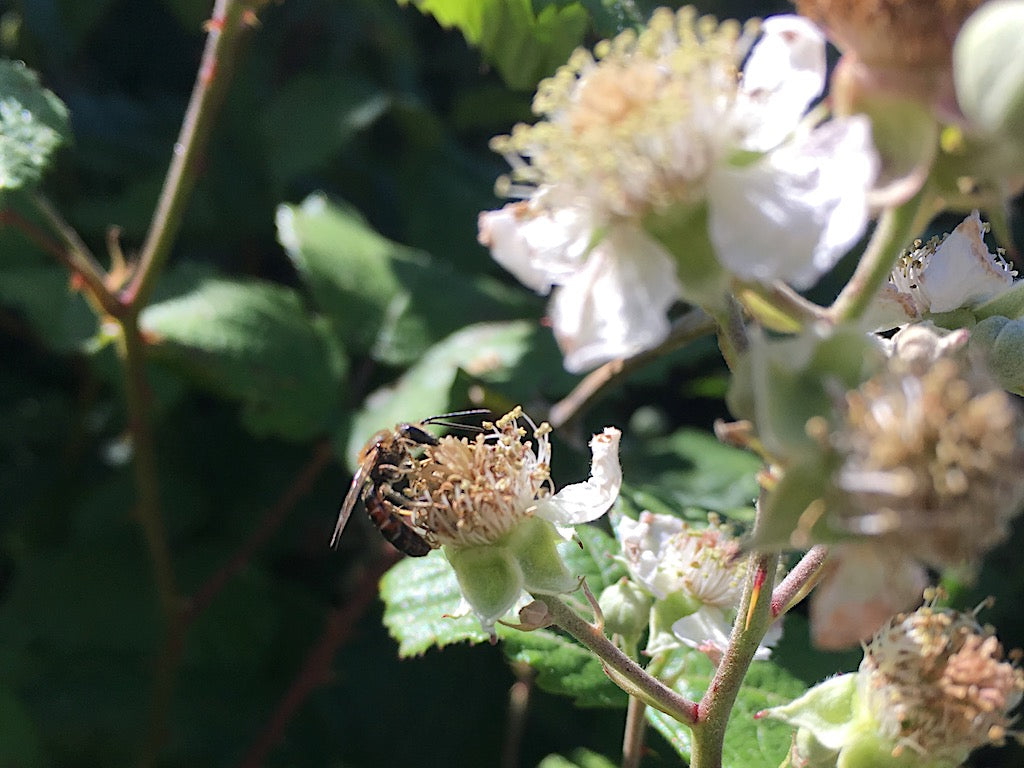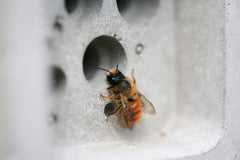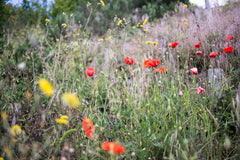
Earn Your Stripes & Celebrate Solitary Bee Week
We are buzzing to be supporting Solitary Bee Week by helping to spread the word about the incredible diversity of bees which are native to the UK - there are over 240 in total and only one species, the honeybee, makes honey.
Obviously we love British honey and British honeybees, but all the other species of British bees are just as fascinating and we think you'll love them too once you get to know them!
Many of us will know a bumblebee when we see one, those big fluffy bees which like honeybees also live in groups, but did you know that most of the UK's bees aren't social and go about their business all alone rather than as part of a group working together!
Solitary Bee Week is a week of action and education to raise awareness of our wonderful solitary bee population. You can Earn your Stripes by pledging to help the solitary bees in one or more of the following ways and you can become a solitary bee hero!
Share your photos on social media using the #solitarybeeweek hashtag and tag us in using @london_honey_co on Instagram so we can follow your great work!
Ways to Pledge to Support Solitary Bees
Plant a seasonal flower or plant
 Nectar rich flowers and plants provide an important source of pollen for solitary bees, who like honeybees are busy pollinating our crops and ensuring that plant communities are healthy. Earn Your Stripes by planting a seasonal pollinator friendly plant in your garden, hanging basket or outdoor plant pot. Check out some of our previous Journal articles on Design Tips for a Bee Friendly Garden that’s worth Showing Off , Sarah Raven on Gardening for Bees Needs & Creating a Buzz in the Garden . We also like the Rosybee website for a useful list and research on the best plants for bees.
Nectar rich flowers and plants provide an important source of pollen for solitary bees, who like honeybees are busy pollinating our crops and ensuring that plant communities are healthy. Earn Your Stripes by planting a seasonal pollinator friendly plant in your garden, hanging basket or outdoor plant pot. Check out some of our previous Journal articles on Design Tips for a Bee Friendly Garden that’s worth Showing Off , Sarah Raven on Gardening for Bees Needs & Creating a Buzz in the Garden . We also like the Rosybee website for a useful list and research on the best plants for bees.
Leave an area of soil exposed
 Roughly 70% of solitary bees are called mining bees and nest in underground burrows up to 60cm deep. These burrows are often marked by small mounds of excavated soil. Do your bit for the bees by leaving an area of your lawn bare, or building a mound of sandy soil in a border or plant pot.
Roughly 70% of solitary bees are called mining bees and nest in underground burrows up to 60cm deep. These burrows are often marked by small mounds of excavated soil. Do your bit for the bees by leaving an area of your lawn bare, or building a mound of sandy soil in a border or plant pot.
Buy or build a house for bees
 Cavity nesting bees, such as red mason bees and leafcutter bees, require dry hollow tubes to lay their young. You can either buy a bee house, such as Green&Blue’s award-winning Bee Brick or make your very own out of recycled materials. We recommend using this guide from the brilliant team at Buglife.
Cavity nesting bees, such as red mason bees and leafcutter bees, require dry hollow tubes to lay their young. You can either buy a bee house, such as Green&Blue’s award-winning Bee Brick or make your very own out of recycled materials. We recommend using this guide from the brilliant team at Buglife.
Grow a wildflower patch
 Although cultivated flower beds and baskets look lovely to humans, solitary bees much prefer long grass, wildflowers and nectar rich dandelions. Allow a metre square patch of your garden to grow wild, sprinkling it with seeds suggested by Roseybee.
Although cultivated flower beds and baskets look lovely to humans, solitary bees much prefer long grass, wildflowers and nectar rich dandelions. Allow a metre square patch of your garden to grow wild, sprinkling it with seeds suggested by Roseybee.
Spread the word
 Give a short five-minute talk about solitary bees in your local community group or with some friends over coffee. Check out the resources page from Solitary Bee Week for factfiles, presentations and solitary bee activities.
Give a short five-minute talk about solitary bees in your local community group or with some friends over coffee. Check out the resources page from Solitary Bee Week for factfiles, presentations and solitary bee activities.
Record a solitary bee
 Get involved with a recording scheme, such as BWARS or The Great British Bee Count, and record a solitary bee in your garden or local park. By taking part, you will be helping experts build their understanding of how solitary bees are coping with threats including habitat loss, pesticides and climate change.
Get involved with a recording scheme, such as BWARS or The Great British Bee Count, and record a solitary bee in your garden or local park. By taking part, you will be helping experts build their understanding of how solitary bees are coping with threats including habitat loss, pesticides and climate change.
Want to read more? Check out Steven Falk's Field Guide to the Bees of Great Britain and Ireland as well as the London Honey Company founders latest book written with Guardian gardening writer Alys Fowler, Letters to a Beekeeper, it includes a wealth of advice, tips and ideas for keeping pollinators well fed.


